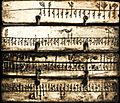Runic calendar facts for kids
A Runic calendar was a special kind of calendar used a long time ago, mostly in Northern Europe. People also called it a Rune staff or Runic Almanac. It was a clever way to keep track of the days, weeks, and years, and it never became outdated! This is why it's called a perpetual calendar.
These calendars were often made from wood or bone. They helped people know when important events were happening, like changes in the seasons or special holidays.
Contents
What Was a Runic Calendar?
A Runic calendar was a bit like a very old-fashioned planner. It was designed to work forever, which is what "perpetual" means. It used a special pattern based on the Moon's cycles, which repeat every 19 years. This pattern is known as the Metonic cycle.
How Did Runic Calendars Work?
Most Runic calendars looked like a staff or a flat piece of wood with many lines of symbols carved into them. These symbols helped people count the days.
- Each day had its own symbol.
- The symbols were often arranged in horizontal lines, one above the other.
Marking Special Days
Important days were marked with extra symbols or special carvings. This made it easy to spot them. These special days included:
- Solstices: The longest and shortest days of the year, when the Sun seems to stand still.
- Equinoxes: Days when day and night are almost exactly the same length.
- Celebrations: This included Christian holidays and other important festivals or feasts.
These calendars were very useful for farmers and communities to know when to plant, harvest, or celebrate.
Images for kids
-
Runic calendar from the Estonian island of Saaremaa with each month on a separate wooden board.
-
Primstav from Hallingdal with coat of arms of Norway, 17th century.
See also
 In Spanish: Calendario rúnico para niños
In Spanish: Calendario rúnico para niños




